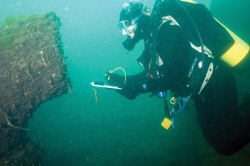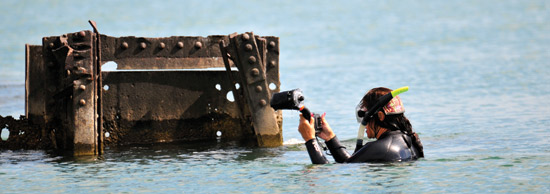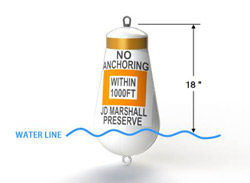- Legal protection of shipwrecks
Divers and snorkelers must follow current Indiana state law. Restrictions to protect shipwrecks and their debris fields while allowing surface recreation include:
- Moving, removing, injuring, possessing, or attempting to move, remove, injure, or possess, a preserved historical resource is prohibited. Per Indiana Code 14-21-1, a permit is required to conduct archaeological field investigations of historic shipwrecks on state property.
- Marking, defacing, placing of any physical objects, or damaging in any way or displacing, removing, or tampering with any official signs, notices, or placards, whether temporary or permanent, or with any navigational aids, monuments, stakes, posts, mooring buoys, boundary buoys, trap buoys, or scientific equipment is prohibited.
- Anchoring can cause irreparable damage to the shipwreck and surrounding area. Hooking the wreck with an anchor is prohibited.
- Additional J.D. Marshall Preserve-specific rules
- The dive boat weight must adhere to the 35,000-pound limit of the mooring buoy.
- Vessels with draft greater than 8 feet are prohibited.
- Anchoring is prohibited in the preserve. Please tie off to the provided mooring buoys. Leave a minimum tail of 6-8 feet of rope slack.
- Discharging or depositing any materials or other matter from within the boundary of the preserve is prohibited.
- Introducing or releasing any exotic species of plant, invertebrate, fish, amphibian, mammal, or physical object into the preserve is prohibited.
- While Diving in Indiana Waters, you also need to:
- Display the diver’s down flag
- Follow standard safe diving practices
- Dive within your limits and level of training
and:
- Know the regulations that apply to diving
- Know the shipping lane locations and the environmental conditions
- Know the dive site well enough to be able to orient yourself with your dive buddy and your surface support or boat.
Warning: Lake Michigan has a flat, sandy bottom with few underwater features to use as navigational reference. After a rain or storm, outfall from local waterways greatly reduces underwater visibility.
This can happen while you are underwater. It is prudent to have an underwater compass to assist with navigating. All items (cultural or biological) and any ship structure and its components are owned by the State of Indiana. Removal of any items is prohibited and threatens the preservation of these sites. Moving items in the debris field, digging around the structure, and “hand fanning” sediment exposes the wreck and can cause further scour and damage to site integrity. Prosecution can result in fines up to an including financial liability for the return of illegally taken items to the lakebed by a commercial salvage/dive firm.
- Are there places I can learn to dive in Lake Michigan so I can dive these sites?
Contact a local scuba store to train to scuba dive in Lake Michigan. There are many stores in Indiana and adjacent states. Some stores offer special scuba training such as "Indiana Lake Michigan Diver" specialty scuba diver certification.
- Safety
 All scuba dives are conducted at the diver’s own risk. The State of Indiana, and Friends of Indiana Dunes State Park accept no responsibility for loss of any kind, including personal injury or property damage, for visitation or use of the J. D. Marshall Nature Preserve.
All scuba dives are conducted at the diver’s own risk. The State of Indiana, and Friends of Indiana Dunes State Park accept no responsibility for loss of any kind, including personal injury or property damage, for visitation or use of the J. D. Marshall Nature Preserve.The State of Indiana assumes no liability for inaccuracies in dive information, site condition information, or the J. D. Marshall Nature Preserve information contained online, including site locations and reported dive conditions. General scuba diving safety guidelines are provided by the World Recreational Scuba Training Council (WRSTC), as well as numerous scuba training agencies and should be adhered to on all scuba dives within the J. D. Marshall Nature Preserve and other sites. All applicable federal and state laws, including scuba dive flag laws, must be adhered to on all scuba dives. Each scuba diving team must employ its own, non-permanent travel line to navigate from the mooring block to the wreck site and remove it after completing its diving activities.
Individual boat captains shall determine on each visit if they can safely use the mooring in the nature preserve. The weather/wave conditions on any given day greatly affect the size of boat that can safely be hooked up. Someone should always be on the surface, onboard the boat, who can effectively operate the boat in bad weather. The mooring buoys are rated for 35,000 pounds of pull. Boats that exceed the limit, based on size, weight and weather conditions, shall not moor to the preserve’s mooring buoy. Visitation to the preserve and tying off on the mooring buoy is recommended in calm weather with waves less than 4 feet high. One boat per buoy is allowed.
This work made possible with Section 309 financial assistance to the Indiana Lake Michigan Coastal Program under Award NA09NOS4190079, NA11NOS4190094, and NA12NOS4190092 provided by the Coastal Zone Management Act of 1972, as amended, administered by the Office for Coastal Management, National Oceanic and Atmospheric Administration.


